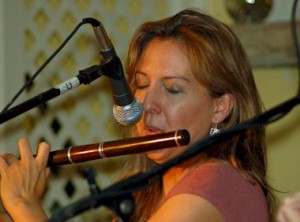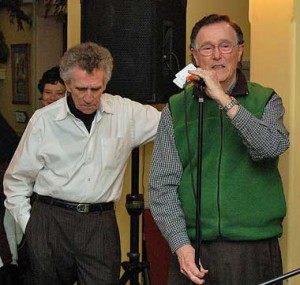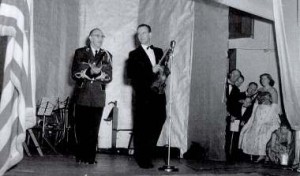If Ed Reavy Jr. ever says to you, “Let me tell you a story,” grab a cuppa, pull up a chair, and prepare to listen.
Reavy is not unlike his father, the legendary hornpipe king of Cavan and Philadelphia, who, session legend has it, could fiddle without stopping all night because one tune always reminded him of another. The younger Reavy can’t tell a story without it bringing up another and then another. If you have the time, it’s a delightful cascade of funny, poignant tales of a life steeped in music, humor, and love.
We were talking the other day (well, he talked, I listened) about the upcoming Ed Reavy Sr. tribute, scheduled for January 19 at the Irish Center in Mt. Airy. Fiddler Jim Eagan, who has recorded a CD of the elder Reavy’s tunes, will be joined by banjo player Peter Fitzgerald, bodhran player Myron Bretholz, and guitarist Andy Thurston in this tribute to the plumber from Cavan who began composing in the 1930s in Philadelphia. Reavy’s traditional tunes, mostly hornpipes, are now played worldwide by everyone from mediocre session players to top trad performers like Eagan, John Carty, Maeve Donnelly, Liz Carroll, Mick Moloney, and many others. (Carroll and fiddle virtuoso Eileen Ivers played Reavy tunes when they won their All-Irelands.)
Ed recalled the first time he met Jim Eagan, a tale that morphed into the back story of one of his father’s “lesser” compositions, “Hughie’s Cap” and a recounting of how his brother Joe’s unceasing dedication and sacrifice saved their father’s music. The story starts with a phone call from bodhran master Myron Bretholz, asking if he and Eagan could talk to Ed and his brother, Joe, about recording a CD of Reavy songs. But, here, let Ed tell it:
“Jimmy came sat in my livingroom and we said, ‘What are you going to play for us? And he said, ‘I can play anything you want.’ I looked at my brother Joe and Joe looked at me. We asked, ‘Don’t you have tunes you already learned to play?’ He said, ‘No, I read them out of the song book.’ So I said, ‘How about playing Kipeen Scanlan’s Horpipe,’ which is my favorite and the most famous Ed Reavy hornpipe in Cavan town. So he opened to book and played it perfectly. We asked him to play Never Was Piping So Gay, and he played that one just about perfectly. After that, he played 8 or 10 more tunes out of the book. Then he said, ‘I also like Hughie’s Cap.’ Well, Joe and I laughed. We thought it was among the least of Dad’s tunes. But we’d heard Seamus Egan and Solas play it, the North American Scottish fiddle champ had put it on his CD, and John Carty of Ireland came up with it as one of his signature tunes. When I met John at the Irish Center, I asked him about it. ‘Hughie’s Cap,’ he said”—here, Reavy shifts into an Irish accent—“’Aw, that’s an awesome piece of music.’ I said, ‘Jesus, John, I don’t believe it. Here, let me tell you a story.’”
This next story takes us back decades, when Philadelphia was an even more Irish city than it is today, and you could go to a house party—where they invited local musicians and pushed the furniture aside for dancing–just about every weekend. Let Ed pick it up again:
“Dad played at house parties all the time. He played in Grays Ferry many many times with John McGettigan, a singer and a bit of a fiddle player. At every house party in Grays Ferry, Hughie McCorkle was invited. Now, he looked for every inch of him a club fighter. He had the pug ears, the flat nose and no hair at all, and he wore this old cap pulled down over his brow. Whenever there was a question of a quarrel or a fight in Grays Ferry, Hughie was there to stick his head in to say”—Reavy raises his voice—“’What’s the problem here?’ and the problem would go away.”
During one house party, a shoving match broke out on the porch. The owner of the house called to a young man at the party. “Go down to the cellar and get Hughie.”
“That’s where the booze was,” Reavy explains. “By God, though, when Hughie came up he didn’t have his cap on, so he didn’t look as menacing. So the owner calls to the boy, ‘Hey kid, run down and tell Annie to give you Hughie’s cap. It’s an emergency.’ So Hughie put on the cap, went out to the porch and said”—Reavy’s voice gets loud again—“’What’s the problem here?’ And then the fight broke up. Joe and I always said that the best thing about the tune was the story.”
Ed and I were both laughing, and it occurred to me that the story he was telling was his Dad’s story, passed down, like the music, to generations. But if it hadn’t been for Ed’s brother, Joe, Ed Reavy’s music might not have been passed down credited to Ed Reavy. Perhaps the finest tribute to his tunes is that they sound like they’ve been handed from one musician to another for centuries, like folklore, so they’re sometimes still found attributed to “anonymous” or, worse, to other composers. “By other noted composers,” Ed adds.
It’s understandable. With the advent of faster, cheaper travel between the US and Ireland and better recording devices (Reavy recorded his own records on a “monstrous” recorder “with about 150 tubes in it” at home, says his son), Reavy’s hornpipes and reels easily made the transatlantic crossing in the ’40s and ’50s. Ed recalls sometimes having to sleep on the floor to accommodate an Irish musician who’d come to Philadelphia to meet with the composer of “Reavy’s tunes,” as they were often called. And fiddler and promoter Louis Quinn, an Armagh man from New York, often brought Reavy recordings to Ireland, where they quickly became part of performers’ repetoires and session staples and were played on Radio Eireann. As Mick Moloney once wrote, the Reavy tunes were happily “adopted,” but in some cases, since they weren’t written down, took on the name of their adoptive “parents.”
But in the 1960s, Joe Reavy began transcribing and annotating his father’s music, not only from the homemade 78s, but from the elder Reavy’s head. It took him seven years, but Joe, who graduated from Penn, eventually produced the first Ed Reavy Sr. songbook, the one that Jim Eagan played from in Ed Reavy Jr.’s livingroom. “No one really knows what that man did for his father’s music,” says Ed admiringly. “He has a disabled daughter, so it was a terrible sacrifice for him and for his wife. I don’t know how he did it, but his wife insisted that he do it.”
Then there were the ones that got away. “Let me tell you another story,” Ed said. “Yes, please,” I answered.
“Before I went back to college I worked with my father in his plumbing and heating business. Every Wednesday I would stay over and work on estimates and bills at an old desk , one of those where the center portion pulled up and a typewriter would come up with it. Dad insisted on doing all the typing, which he did with three fingers on both hands. There was a stack of homemade recordings in the corner of the desk against the wall. It was at least 10 inches high. I had never really noticed them until one night, when he was typing, the vibrations caused them to fall into the typewriter well. He reached in a put them back in the corner, then went on typing. Well, they fell down again, so he took the whole batch and threw them in the wastebasket. I asked him why he did that. He said, ‘They’re getting on my nerves and they’re just barn dances.’ I didn’t know he was composing barn dances (a type of Irish tune). So I asked him again why he threw them away. He said, ‘You know, Eddie, I give a tune an hour, and if I can’t do anything with it, I discard it. I won’t discard it if I like the melody, and if I like the melody, I make a barn dance out of it. Now Eddie, barn dances are here today and gone tomorrow and no one cares who composes them.’
“Well, I’m a dancer,” says Ed Reavy, Jr, who has the enviably slim build to prove it . “So you would think I would have reached into that wastebasket and pulled those records out. But I didn’t. I still don’t know to this day why I didn’t. If I had, we would have had a whole book of Ed Reavy barn dances today.”




